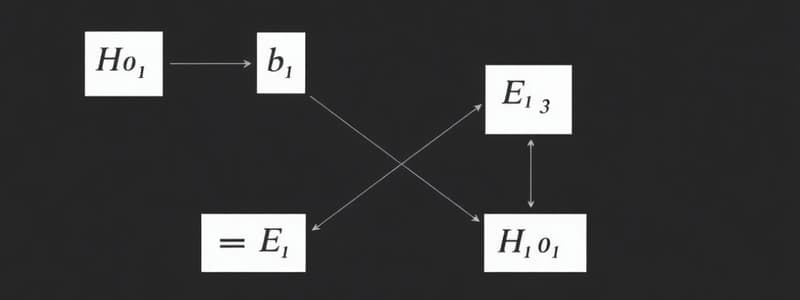Podcast
Questions and Answers
What does the symbol ~ represent in propositional logic?
What does the symbol ~ represent in propositional logic?
- IF-THEN
- OR
- AND
- NOT (correct)
Which of the following statements correctly represents a conjunction?
Which of the following statements correctly represents a conjunction?
- It is not raining.
- If it is raining, then I will bring an umbrella.
- It is raining and I will bring an umbrella. (correct)
- It is raining or I will get wet.
What does the proposition p → q indicate?
What does the proposition p → q indicate?
- If p is true, then q is also true. (correct)
- p is false if q is true.
- p or q is true.
- p is true if and only if q is true.
What does the biconditional statement p ↔ r express?
What does the biconditional statement p ↔ r express?
In the expression p ∧ (q ∨ ~r), what does the parentheses signify?
In the expression p ∧ (q ∨ ~r), what does the parentheses signify?
Which statement correctly describes a simple statement?
Which statement correctly describes a simple statement?
Which of the following is an example of a disjunction?
Which of the following is an example of a disjunction?
Which logical connective indicates a conditional relationship?
Which logical connective indicates a conditional relationship?
What does the symbol ∨ represent in logic?
What does the symbol ∨ represent in logic?
Which logical connective is used for 'if...then' statements?
Which logical connective is used for 'if...then' statements?
In the statement 'p and q or not r,' how are p and q grouped?
In the statement 'p and q or not r,' how are p and q grouped?
What does the symbol ∧ signify in logic?
What does the symbol ∧ signify in logic?
Which of the following correctly illustrates how grouping affects logical interpretation?
Which of the following correctly illustrates how grouping affects logical interpretation?
What does the symbol ~ represent in logical notation?
What does the symbol ~ represent in logical notation?
In the context of compound statements, what does the comma indicate?
In the context of compound statements, what does the comma indicate?
What logical statement corresponds with 'If it is raining, then I will bring an umbrella'?
What logical statement corresponds with 'If it is raining, then I will bring an umbrella'?
Flashcards are hidden until you start studying
Study Notes
Introduction to Propositional Logic
- Propositional logic is concerned with truth values, "true" and "false", assigned to statements.
- A proposition or statement is a declarative sentence classified as either true or false.
- Statements are represented by letters, such as p, q, and r.
Connectives and Symbols
- Not: Represented by ~p (negation)
- And: Represented by p∧q (conjunction)
- Or: Represented by p∨q (disjunction)
- If-Then: Represented by p→q (conditional)
- If and Only If: Represented by p↔q (biconditional)
Simple and Compound Statements
- A simple statement conveys a single idea.
- A compound statement conveys two or more ideas.
- Compound statements are formed using logical connectives.
- Parentheses are used in symbolic form to group simple statements within a compound statement.
- Commas are used in an English sentence to group simple statements within a compound statement.
Example: Weather and Actions
-
p: "It is raining."
-
q: "I will bring an umbrella."
-
r: "I will get wet."
-
Compound Statements:
- ~p: "It is not raining."
- p ∧ q: "It is raining, and I will bring an umbrella."
- p ∨ r: "It is raining, or I will get wet."
- p → q: "If it is raining, then I will bring an umbrella."
- p ↔ r: "I will get wet if and only if it is raining."
Grouping Symbols
- Grouping symbols help to define the order of operations in complex statements.
- Example: p ∧ (q ∨ ~r) indicates that q and ~r are grouped together, then the result is combined with p.
- Example: (p ∧ q) ∨ r indicates that p and q are grouped together, then the result is combined with r.
Truth Values
- The truth value of a compound statement is determined by the truth values of its simple statements and the connective in use.
- Different connectives have different truth value tables that define their behavior.
- Example: 2 ≤ 5 is a compound statement with two component propositions, which are:
- p: 2
- q: 5
Studying That Suits You
Use AI to generate personalized quizzes and flashcards to suit your learning preferences.




